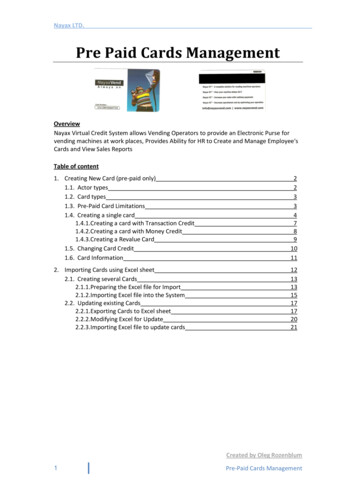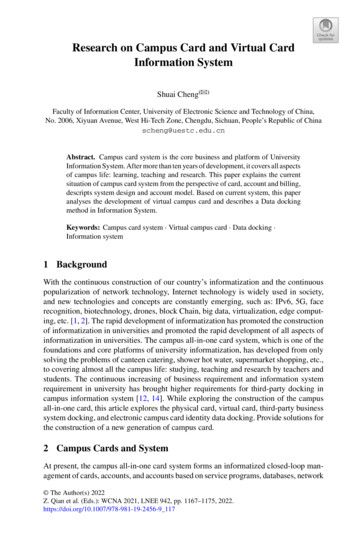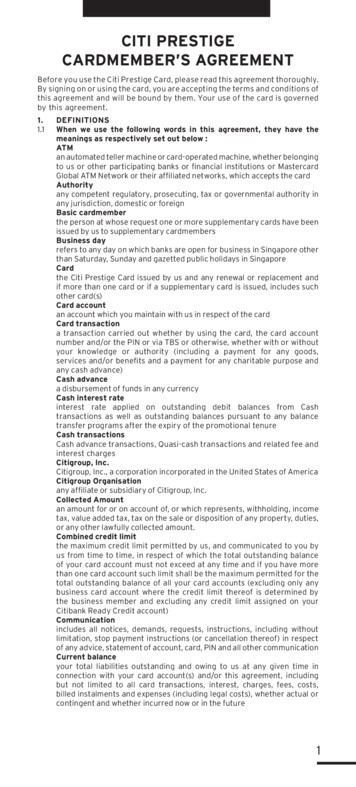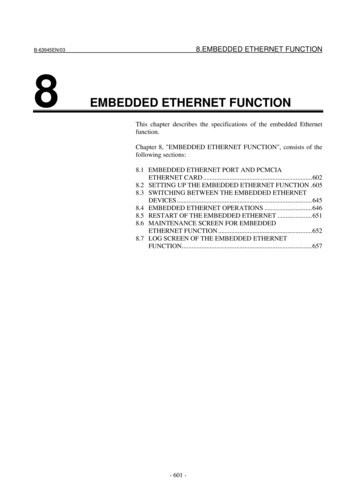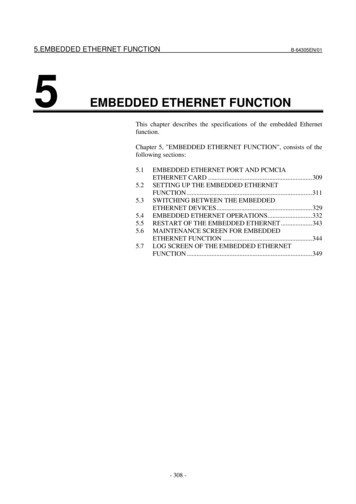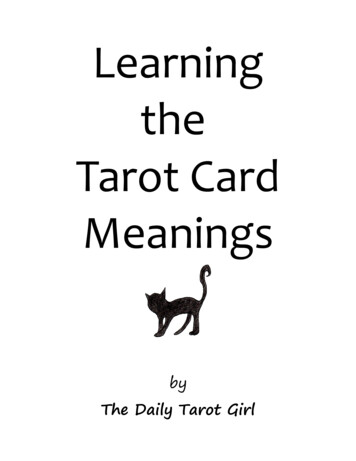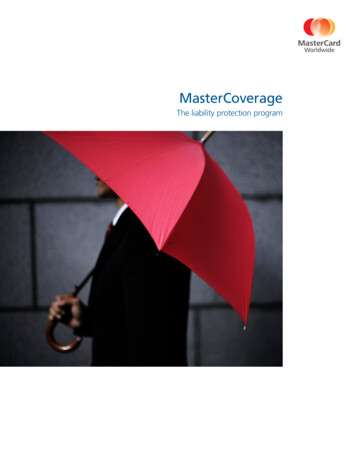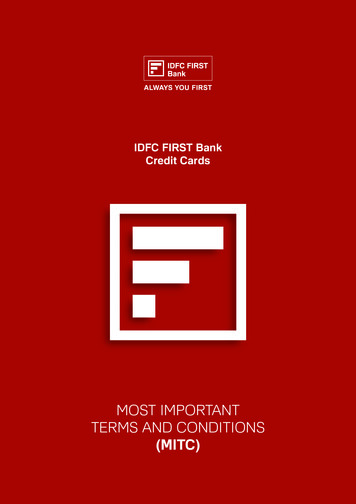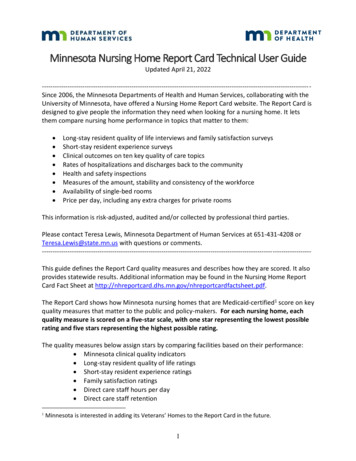
Transcription
Minnesota Nursing Home Report Card Technical User GuideUpdated April 21, -----------------------------Since 2006, the Minnesota Departments of Health and Human Services, collaborating with theUniversity of Minnesota, have offered a Nursing Home Report Card website. The Report Card isdesigned to give people the information they need when looking for a nursing home. It letsthem compare nursing home performance in topics that matter to them: Long-stay resident quality of life interviews and family satisfaction surveysShort-stay resident experience surveysClinical outcomes on ten key quality of care topicsRates of hospitalizations and discharges back to the communityHealth and safety inspectionsMeasures of the amount, stability and consistency of the workforceAvailability of single-bed roomsPrice per day, including any extra charges for private roomsThis information is risk-adjusted, audited and/or collected by professional third parties.Please contact Teresa Lewis, Minnesota Department of Human Services at 651-431-4208 orTeresa.Lewis@state.mn.us with questions or ----------------------------------This guide defines the Report Card quality measures and describes how they are scored. It alsoprovides statewide results. Additional information may be found in the Nursing Home ReportCard Fact Sheet at et.pdf.The Report Card shows how Minnesota nursing homes that are Medicaid-certified1 score on keyquality measures that matter to the public and policy-makers. For each nursing home, eachquality measure is scored on a five-star scale, with one star representing the lowest possiblerating and five stars representing the highest possible rating.The quality measures below assign stars by comparing facilities based on their performance: Minnesota clinical quality indicators Long-stay resident quality of life ratings Short-stay resident experience ratings Family satisfaction ratings Direct care staff hours per day Direct care staff retention1Minnesota is interested in adding its Veterans’ Homes to the Report Card in the future.1
Minnesota Nursing Home Report Card Technical User GuideUpdated April 21, 2022Facility performance on these measures generally represents a normal distribution. A normaldistribution means that most of the results are close to the statewide average, with a fewoutliers both higher and lower than the average. If the data were graphed for these measures,the graphs would look like a bell-shaped curve.For each of these measures, the mean (average) is determined for the data set. The standarddeviation for the data set is then calculated. The standard deviation is a statistic that tells howtightly the results are clustered around the average. When the results are tightly bunchedtogether around the average, the standard deviation is small. When the results are morewidespread, the standard deviation becomes larger. A standard deviation may be thought of asthe average of the differences from the mean. The thresholds for assigning stars to eachfacility’s performance are as follows:5 Stars: Mean plus 1½ standard deviations4 Stars: Mean plus ½ to 1½ standard deviations3 Stars: Mean plus or minus ½ standard deviations2 Stars: Mean minus ½ to 1½ standard deviations1 Star: Mean minus 1½ standard deviationsThree of the measures – long-stay resident quality of life, short-stay resident experience, andfamily satisfaction – are based on survey information. The variation in the number of surveyscollected per facility presents a challenge. Facilities with fewer surveyed residents are morelikely than facilities with many surveyed residents to have very high or very low scores due tostatistical error rather than real differences in the resident or family experience. To deal withthis issue, the Report Card uses a statistical approach called hierarchical linear modeling todevelop empirical Bayes (EB) estimated scores. Experts contend that the EB approach results inmore accurate estimates when comparing facilities. EB estimation is viewed as more “fair” forfacilities with fewer surveyed residents than comparing facilities on their observed (so-calledunadjusted) rates.MN CLINICAL QUALITY INDICATORSDuring their stay in a nursing home, residents are assessed by the facility staff. This extensiveassessment, called the Minimum Data Set (MDS), includes many items such as: diagnoses; theability to do activities of daily living (ADL) such as getting in and out of bed, walking, eating,bathing, toileting, etc.; clinical conditions; use of certain types of medications; mentalfunctioning; and treatments provided to the resident in the facility.2
Minnesota Nursing Home Report Card Technical User GuideUpdated April 21, 2022Selected items from the MDS have been identified as indicators of the quality of care providedto the resident. These quality indicators are risk adjusted to account for differences betweenthe types of residents served in nursing homes. Examples of the adjustors used are, but are notlimited to: age, gender, cognitive performance (mental functioning), Alzheimer’s disease,stroke, and ADL ability. For MDS items not available on the current assessment, the systemautomatically looks back to the most-recent available data.The Report Card provides two clinical quality indictor star ratings: one focused on the quality ofcare during long-term stays, and one focused on the quality of care during short-term stays.The long-stay clinical star rating includes 19 indicators over ten topics important to the longstay experience. These are shown in the table below:Long-stay Quality Indicators from the MDS Included in ScoreDomainNameDescriptionPsychosocialWorsening or SeriousResident BehaviorProblemsPrevalence of DepressiveSymptomsThis is the percent of residents with verbal, physical, or otherdisruptive behavior symptoms that have worsened or have stayedat the most serious level since the last assessment.This is the percent of long-stay residents who are exhibiting signsof depression. This is determined by a standardized resident moodinterview or if interview is not possible, by staff assessment.Quality ofLifePrevalence of PhysicalRestraintsThis is the percent of long-stay residents who were physicallyrestrained. A physical restraint is any device, material orequipment attached or adjacent to a resident’s body, that aresident can’t remove easily, which keeps a resident from movingfreely or prevents them normal access to their body. Side rails onbeds are not included in this calculation.ContinenceWorsening or SeriousBowel IncontinenceThis is the percent of long-stay residents whose ability to controltheir bowel has gotten worse or stayed at the most serious levelsince the last assessment. Residents who need an appliance suchas an ostomy for bowel movements are not included in thecalculation of this measure.This is the percent of long stay-residents whose ability to controltheir bladder has gotten worse or stayed at the most serious levelsince the last assessment. Residents who need an appliance suchas catheter for urination are not included in the calculation of thismeasure.Worsening or SeriousBladder Incontinence3
Minnesota Nursing Home Report Card Technical User GuideUpdated April 21, 2022Long-stay Quality Indicators from the MDS Included in ScoreDomainNameDescriptionPrevalence of Occasionalto Full BladderIncontinence Without aToileting PlanThis is the percent of long-stay residents who lose control of theirbladder and are not on a documented individualized bladdertoileting program.Prevalence of Occasionalto Full BowelIncontinence Without aToileting PlanThis is the percent of long-stay residents who lose control of theirbowel and are not on a documented individualized bladdertoileting program.Prevalence of IndwellingCathetersThis is the percent of long-stay residents who had a catheterinserted and left in their bladder for a period of time.Prevalence of UrinaryTract InfectionsThis is the percent of long-stay residents who had an infection intheir urinary tract.Prevalence of InfectionsThis is the percent of long-stay residents who have had aninfection. This may include drug-resistant infections, some woundinfections, pneumonia, viral hepatitis, and septicemia.AccidentsPrevalence of Falls withMajor InjuryThis is the percent of long-stay residents who have experiencedone or more falls with major injury (e.g. bone fractures, jointdislocations, closed head injuries with altered consciousness,subdural hematoma).NutritionPrevalence ofUnexplained Weight LossThis is the percent of long-stay residents who have lost too muchweight and are not on a physician-prescribed weight loss regimen.Skin CarePrevalence of PressureSores in High-RiskResidentsPsychotropicDrugsPrevalence ofAntipsychotics Without aDiagnosis of PsychosisThis is the percent of long-stay residents with a high risk forgetting pressure sores that have one or more pressure sores.Residents are defined as high risk if they are comatose,malnourished , or have an impaired ability to move themselves inbed or transfer from bed to chair, etc.This is the percent of long-stay residents who receive anantipsychotic medication. Some residents with a serious mentalillness diagnosis such as Schizophrenia are not included in thecalculation of this measure.PhysicalFunctioningWorsening or SeriousFunctional DependenceInfectionsThis is the percent of long-stay residents whose need for helpdoing basic tasks has increased or stayed at the highest level sincethe last assessment. These tasks include feeding oneself, movingfrom one chair to another, changing positions in bed and/or goingto the bathroom. Residents with quadriplegia are not included inthe calculation of this measure.4
Minnesota Nursing Home Report Card Technical User GuideUpdated April 21, 2022Long-stay Quality Indicators from the MDS Included in ScoreDomainNameDescriptionWalking as Well orBetter than PreviousAssessmentThis is the percent of long-stay residents who have the same orimproved independence in walking ability since the lastassessment.Worsening or SeriousMobility DependenceThis is the percent of long-stay residents whose need for helpmoving in and around their room has increased or stayed at thehighest level since the last assessment. Residents withquadriplegia are not included in the calculation of this measure.This is the percent of long-stay residents whose ability to move thejoints of their upper or lower extremities has declined or stayed atthe lowest level since the last assessment. Residents withquadriplegia are not included in the calculation of this measure.Worsening or SeriousRange of MotionLimitationPainPrevalence of Residentswho Report Moderate toSevere PainThis is the percent of long-stay residents who reported havingmoderate to severe pain.Each long-stay domain is assigned 10 points and within each domain the points are distributedequally. Finally, the domains are added into a total score for a maximum 100 points. Stars areassigned using the standard deviation methodology described on Page 2 of this user guide. Thethresholds and statewide distribution for the period January 1, 2021 through December 31,2021 are as follows:Long-Stay Clinical Quality Indicators(Lowest 27.1652, Mean 63.9432, Highest 92.4871)# Stars54321N/ALong-Stay Clinical QI Score 253957.632445.0109N/A# NFs259111882267The short-stay clinical quality star rating includes four indicators representing four topicsimportant to the short-stay experience. These are shown in the table below:5
Minnesota Nursing Home Report Card Technical User GuideUpdated April 21, 2022Short-stay Quality Indicators from the MDS Included in ScoreDomainNameDescriptionHospitalizationPercent ofHospitalizationsSkin CarePrevalence of New orWorsening PressureSoresThis is the number of residents who are sent to the hospital forany reason within 30 days of their admission to the nursing home,divided by the facility’s total annual admissions. In addition toresident conditions, it is risk-adjusted for facility size and location.This is the percent of short-stay residents who have developedpressure sores or who had pressure sores that got worse sinceadmission.PainPrevalence of Residentswho Report Moderateto Severe PainThis is the percent of short-stay residents who report havingmoderate to severe pain. Although pain is common duringrecovery and rehabilitation from a major illness or injury, it is stillimportant to identify and treat pain.Going HomePercent of CommunityDischargesThis is the number of residents who return to the communitywithin 30 days of their admission to the nursing home, divided bythe facility’s total annual admissions. This includes any lessrestrictive setting such as a private home/apartment, board andcare, assisted living, or group home. In addition to residentconditions, it is risk-adjusted for facility size, location and localavailability of home and community based services.Each short-stay domain is assigned 10 points which are then added into a total score, for amaximum of 40 points. Stars are assigned using the standard deviation methodology describedon Page 2 of this user guide. The thresholds and statewide distribution for the period January1, 2021 through December 31, 2021 (for Community Discharges, October 1, 2020 throughSeptember 30, 2021) are as follows:Short-Stay Clinical Quality Indicators(Lowest 3.7254, Mean 23.865, Highest 40.000)# Stars54321N/AShort-Stay Clinical QI Score 228.2897820.6653413.04090N/A6# NFs219313376260
Minnesota Nursing Home Report Card Technical User GuideUpdated April 21, 2022LONG-STAY RESIDENT QUALITY OF LIFE SURVEYSEach year, trained staff employed by an independent contractor of the State interview long-stayresidents in every nursing home about their quality of life. Interviewers invite a random sampleof residents to participate, unless they are severely cognitively impaired, ill or their guardianrefuses on their behalf.Interviewers use a standardized survey that measures resident quality of life over a variety oftopics or domains. These include meaningful activities, food enjoyment, environment, dignity,autonomy, relationships, caregiving and mood. Researchers at the University of Minnesotadesigned the survey for use by people with memory loss, cognitive impairments, and otherdisabilities. To view it, visit ndex.html.The State calculates a quality of life score by averaging each domain, then finding the averageof these domain scores. The score is then risk-adjusted to account for resident and facilitycharacteristics that are generally not controlled by facility staff. The score uses four riskadjusters for residents — age, gender, cognitive performance (Cognitive Performance Scale orBrief Interview for Mental Status) and Activities of Daily Living score (ADL Long-Form). It alsoadjusts for facility location – Twin Cities metropolitan area vs. greater Minnesota. The averagescores of residents who are older, female, and/or more cognitively impaired tend to be higher;residents with more ADL dependencies tend to rate their quality of life lower. In addition,average scores tend to be higher for facilities located in greater Minnesota.Stars are assigned using the standard deviation approach described above. Nursing facilitiesthat provide little or no long-stay care do not participate in this survey. These facilities areindicated by “n/a” on their star rating. The COVID-19 pandemic required the state to cancelinterviews in fall 2020. Thresholds and the statewide distribution for the September throughDecember 2019 wave of interviews are as follows:Long-Stay Resident Quality of Life: Possible Score Range 0-100(Lowest Score 70.918, Mean 80.9823, Highest Score 89.708)# Stars54321N/ALong-stay Resident Quality of LifeSummary Score 79.4895076.4976N/AN/A7# NFs2081151573010
Minnesota Nursing Home Report Card Technical User GuideUpdated April 21, 2022SHORT-STAY RESIDENT EXPERIENCE SURVEYSTo learn about the short stay experience, the State mails a survey to people who have been in anursing home for 30 days or less and have returned home. This survey focuses on key topicspeople value when they stay in a facility short-term versus permanently. In particular, thesurvey asks about admission, physical therapy, clinical care, and discharge. It also includesquestions on assistance from staff, communication, dining, the environment and safety, andpeople’s overall satisfaction with the nursing home. To view the short-stay survey, ts.html.The State calculates a resident experience score by calculating an average score for each topicor domain, then finding the average of these domain scores. The score is then risk-adjusted toaccount for selected resident and facility characteristics that are not controlled by facility staff.The score uses two risk adjusters: whether residents report assistance with completing thesurvey, and facility location in the Twin Cities metropolitan area vs. greater Minnesota.Residents who get help (from a family member, friend or other person) report less satisfactionwith their experience than those who complete the survey on their own. In addition, averagescores tend to be higher for facilities located in greater Minnesota.Stars are assigned using the standard deviation approach described above. Nursing facilitiesthat provide little or no short-stay care do not participate in this survey. These facilities areindicated by “n/a” on their star rating. The thresholds and statewide distribution for theFebruary 2021 through January 2022 wave of surveys are as follows:Resident Short Stay Experience: Possible Score Range 0-100(Lowest Score 56.5490, Mean 82.3246, Highest Score 92.7793)# Stars54321N/AShort-stay Resident ExperienceSummary Score 79.0575072.5234N/AN/A# NFs140451711235FAMILY SATISFACTION SURVEYSFamily, friends and other people involved in residents’ lives often have different concerns aboutthe stay than their loved ones. Each year, an independent contractor of the State mails a family8
Minnesota Nursing Home Report Card Technical User GuideUpdated April 21, 2022satisfaction survey to the primary responsible party of every long-stay resident. The number ofsurveys mailed for each facility varies based on the number of residents in the facility with aresponsible party. The survey measures family satisfaction over four key topics or domains.These include staff, care, environment and food. To view the family survey, ces/index.html.The State calculates a family satisfaction score by calculating an average score for each domain,then finding the average of these domain scores. The summary score is then risk-adjusted tocontrol for family and facility characteristics that are not controlled by facility staff. The scoresuse six risk adjusters, five for respondents (relationship to the resident, gender, frequency ofvisits and other communication with the resident, and survey format) and one for nursinghomes (Twin Cities metropolitan vs. greater Minnesota).Respondents who are male, in a less intimate relationship with the resident (e.g. professionalguardian vs. spouse), have less frequent contact with the resident, and/or complete the surveyon the phone vs. on paper or online tend to be more satisfied. In addition, average scores tendto be higher for nursing homes located in greater Minnesota.Stars are assigned using the standard deviation approach described above. Nursing facilitiesthat provide little or no long-stay care do not participate in this survey. These facilities areindicated by “n/a” on their star rating. The COVID-19 pandemic required the state to cancelfamily surveys in winter 2020. Thresholds and the statewide distribution for the October 2019through February 2020 wave of surveys are as follows:Family Satisfaction: Possible Score Range 0-100(Lowest Score 51.6001, Mean 75.4706 Highest Score 97.0853)# Stars54321N/AFamily SatisfactionSummary Score 72.2459065.8775N/AN/A9# NFs1695124712617
Minnesota Nursing Home Report Card Technical User GuideUpdated April 21, 2022STATE INSPECTION RESULTSAt least every 15 months, the Minnesota Department of Health (MDH) conducts a survey ofhealth care and resident safety and the Minnesota Department of Public Safety conducts a lifesafety code survey of the physical plant at each nursing home in the State. If necessary,inspectors revisit facilities to ensure that any deficiencies cited during a survey are corrected.Facilities also may be inspected at any time if a resident or advocate makes a complaint, or iffacility staff report suspected resident abuse or neglect as required by state law.Note: Due to the COVID-19 pandemic, the Federal Centers for Medicare and Medicaid Servicessuspended standard state inspections on March 4, 2020, resuming fall 2020. Nursing homes willshow “n/a” until a standard inspection is complete.The statewide distribution of health and safety inspection results determined on March 2,2022 is as follows:State Inspection Results# Stars54321N/AState Inspection Results# Points Earned107.552.50N/A# NFs1151557315126The state inspection measure is based on the following five criteria. Key terms used in themeasure are defined below.1) If the facility’s most-recent available health and life-safety code survey had actualharm, substandard quality of care, or immediate jeopardy2) If the facility had a complaint investigation(s) that resulted in deficiencies issued atactual harm, substandard quality of care, or immediate jeopardy over the past year3) If the facility’s prior health survey had substandard quality of care or immediatejeopardy4) If the facility is on the Special Focus list of providers judged by MDH and the federalCenters for Medicare and Medicaid Services as needing additional oversight5) If the facility has a high number of health deficiencies10
Minnesota Nursing Home Report Card Technical User GuideUpdated April 21, 2022The state inspection measure judges a nursing home’s performance to be OK or not OK on eachof these five criteria. Finally, the measure combines these criteria for the following star ratings:5 Stars Most-recent available survey OKPrior survey OKOne-year complaints investigation record OKNot a Special Focus facilityNot a high number of health deficiencies4 Stars Most-recent available survey OKOne-year complaints investigation record OKNot a Special Focus facility3 Stars Most-recent available survey OK, allowing ONE isolated instance of actual harmOne-year complaints investigation record OK2 Stars Most-recent available survey not OKOne-year complaints investigation record OKORMost-recent available survey OK, allowing ONE isolated instance of actual harmOne-year complaints investigation record not OK1 Star Most-recent available survey not OKOne-year complaints investigation record not OKKey TermsScope and severity are used to categorize the seriousness of a health or life safety deficiency(see the table below). Scope refers to how widespread the problem is, and can be isolated,patterned, or widespread. Severity ranges from no actual harm with a potential for minimalharm, to situations of immediate jeopardy to resident health or safety.11
Minnesota Nursing Home Report Card Technical User GuideUpdated April 21, 2022Scope and Severity Levels for Health Inspection Deficiency CitationsSeverityScope & Severity JIsolated Immediate jeopardyto resident health or safety.Scope & Severity KPatterned – Immediatejeopardy to resident health orsafety.Scope & Severity LWidespread – Immediatejeopardy to resident health orsafety.Scope & Severity GIsolated – Actual Harm that isnot immediate jeopardy.Scope & Severity HPatterned – Actual Harm thatis not immediate jeopardy.Scope & Severity IWidespread – Actual Harm thatis not immediate jeopardy.Scope & Severity DIsolated - No actual harm withpotential for more thanminimal harm that is notimmediate jeopardy.Scope & Severity EPatterned - No actual harmwith potential for more thanminimal harm that is notimmediate jeopardy.Scope & Severity FWidespread - No actual harmwith potential for more thanminimal harm that is notimmediate jeopardy.Scope & Severity AIsolated - No actual harm withpotential for minimal harm.Scope & Severity BPatterned - No actual harmwith potential for minimalharm.Scope & Severity CWidespread - No actual harmwith potential for minimal harm.ScopeActual harm includes any deficiency citation where actual physical or emotional harm to aresident has been identified. Harm can occur in any citation with a scope and severity level “G”through “L.”Substandard quality of care means one or more deficiencies related to participationrequirements under 42 CFR 483.10, resident rights, 42 CFR 483.12, freedom from abuse,neglect, and exploitation, 42 CFR 483.24, quality of life, 42 CFR 483.25, quality of care, 42 CFR483.40, behavioral health services, 42 CFR 483.45, pharmacy services, 42 CFR 483.70,administration, or 42 CFR 483.80, infection control, that constitutes either immediate jeopardyto resident health or safety, a pattern of or widespread actual harm that is not immediatejeopardy, or a widespread potential for more than minimal harm, but less than immediatejeopardy, with no actual harm (that is, a scope and severity of “F” or higher but not equal to“G” as “G” represents isolated and not patterned harm). Defined in the CMS state operationsmanual chapter 7, section 7001Immediate jeopardy means a situation in which the facility’s noncompliance with one or morerequirements of participation has caused, or is likely to cause, serious injury, harm, impairment,or death to a resident. Defined in the CMS state operations manual chapter 7, section 700112
Minnesota Nursing Home Report Card Technical User GuideUpdated April 21, 2022Special Focus Provider is a nursing home deemed by the Department of Health and the Centersfor Medicare and Medicaid Services to be performing at a level where additional oversight isneeded to assure compliance with government regulations.High number of deficiencies means that the total number of deficiency citations issued to afacility on the most-recent available health survey is greater than the average of high statewideand high survey district deficiencies, determined by the following formula: [(Minnesota’s average deficiencies plus ½ standard deviation for previous calendar year) (survey district’s average deficiencies plus ½ standard deviation for previous calendar year)] / 2State Survey Process1. Surveys are unannounced and usually conducted during weekdays. However, surveyteams can and do conduct inspections at night, on weekends and on holidays.2. Surveyors are trained health care professionals in nursing, nutrition, social work,pharmacy and sanitation.3. A Life Safety Code component of the survey focuses on safety to life from fire inbuildings and structures.4. A report is sent to the facility following each survey.5. When regulatory requirements have not been met, the nursing facility may be fined foreach violation cited and must submit a plan of correction to MDH. MDH must find theplan acceptable before the facility is found to be back in compliance.6. Survey results must be made available to residents, families and other interestedparties. To access a nursing home’s detailed survey inspection reports, click the HealthSurvey Inspection Findings link at the bottom of their Report Card star page.STAFF HOURS OF DIRECT CARE PER RESIDENT DAYThe source of the data to compute the facility average direct care hours per resident day isthe annual statistical report filed with DHS for the 12-month period ending September 30,2020. The following list describes the steps taken to determine facility average staffing levels.1) Figures are for Nursing Facility (NF) days and Nursing Facility-II (NFII) days (Report lines5001 to 5100).2) Both regular and pool productive hours are included (Report lines 0301 to 0320).3) Productive hours are converted into Hours per Resident Day figures: RN hours /resident days, LPN hours / resident days, etc.13
Minnesota Nursing Home Report Card Technical User GuideUpdated April 21, 20224) Hours per Resident Day are weighted for relative cost per staff type (statewide averagesalary ratios, carried over from 2019 due to large temporary funding changes in 2020):Staff typeDON/Nurse administratorRNLPNCertified Nursing AssistantTMAMental health workerSocial workerActivity staffOther direct care workerRatio2.171.901.451.001.081.841.601.001.315) Sum of cost weighted hours (DON hrs paid * DON cost wt) (RN hrs paid * RN costwt) (LPN hrs paid * LPN cost wt) (CNA hrs paid * CNA cost wt) (TMA hrs paid * TMAcost wt) (MH hrs paid * MH cost wt) (SW hrs paid * SW cost wt) (ACT hrs paid *ACT cost wt) (OTH hrs paid * OTH cost wt).6) Sum of cost-weighted hours is adjusted for facility acuity: Adjusted Hrs paid (Sum ofcost weighted hours) / Facility average case-mix index.For purposes of comparing staffing levels, all nursing homes in the state are grouped into threetypes of facilities:1) Hospital peer group: hospital-attached, Rule 80 and facilities with three or moreadmissions per bed per year.2) Nursing facility-II peer group: facilities with more than 50 percent of their bedslicensed as boarding care homes.3) Standard peer group: all other facilities.The mean staffing level and associated standard deviation are calculated separately
Minnesota Nursing Home Report Card Technical User Guide Updated April 21, 2022 1 ----- Since 2006, the Minnesota Departments of Health and Human Services, collaborating with the University of Minnesota, have offered a Nursing Home Report Card website. The Report Card is designed to give people the information they need when looking for a .
